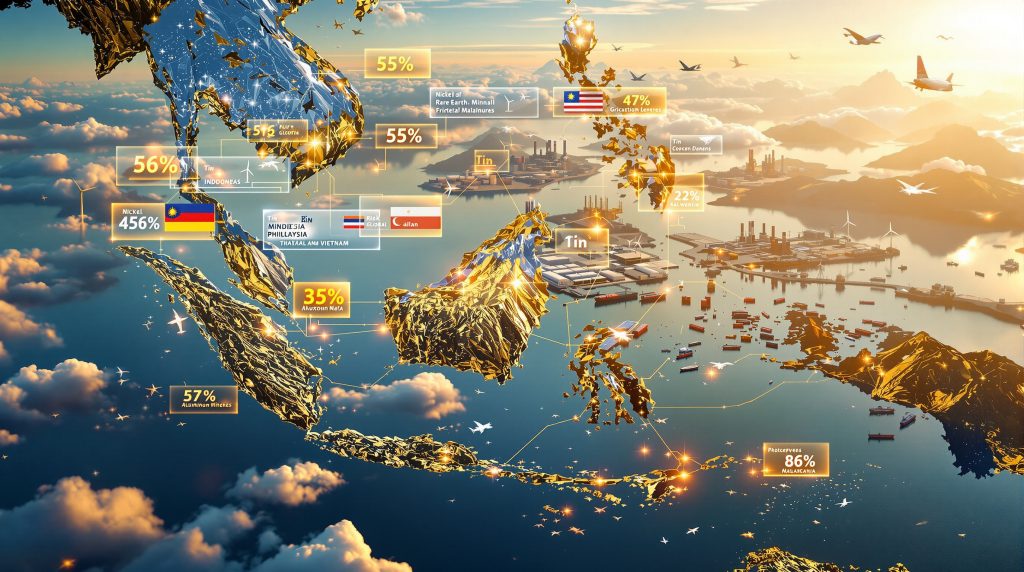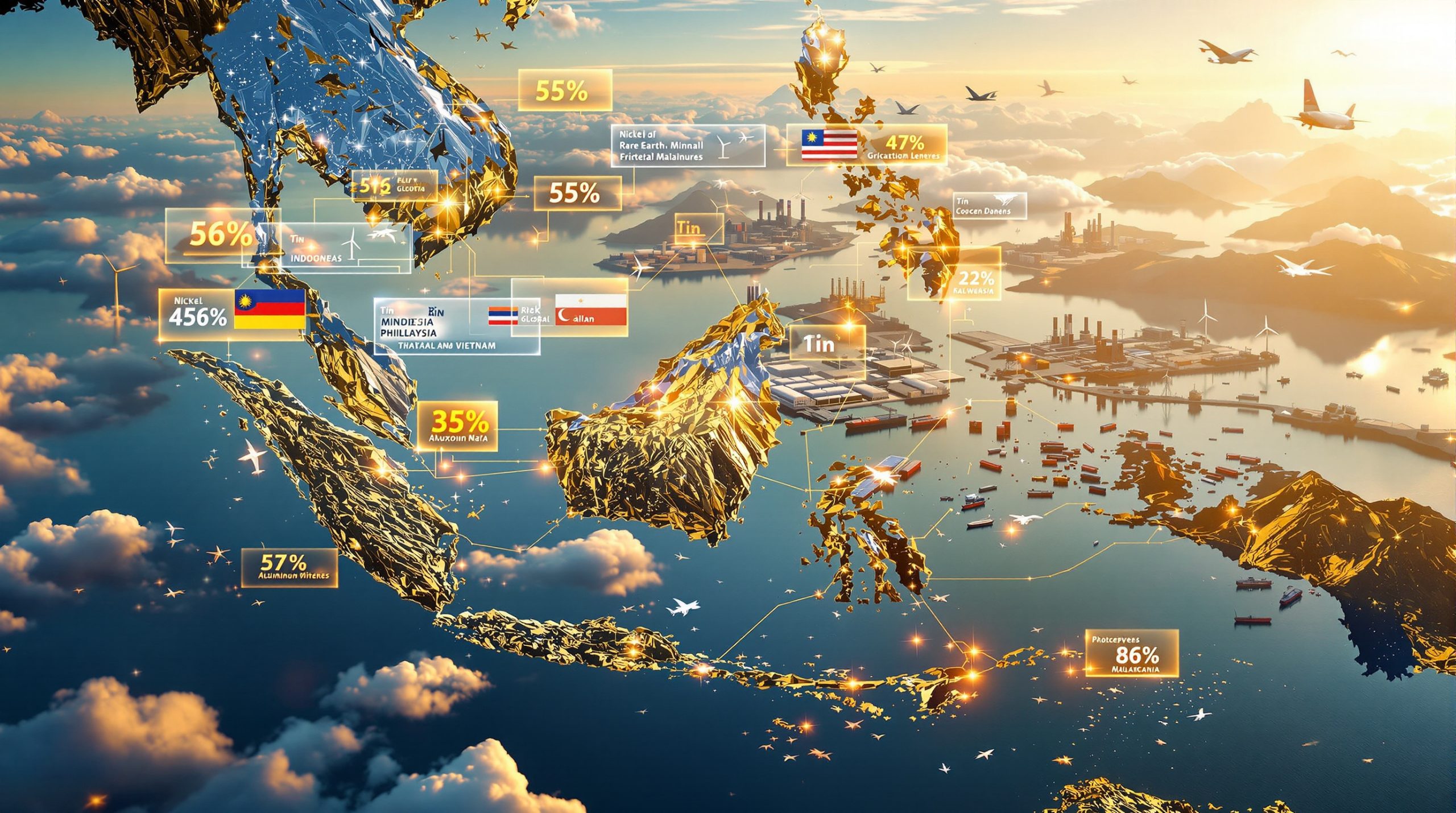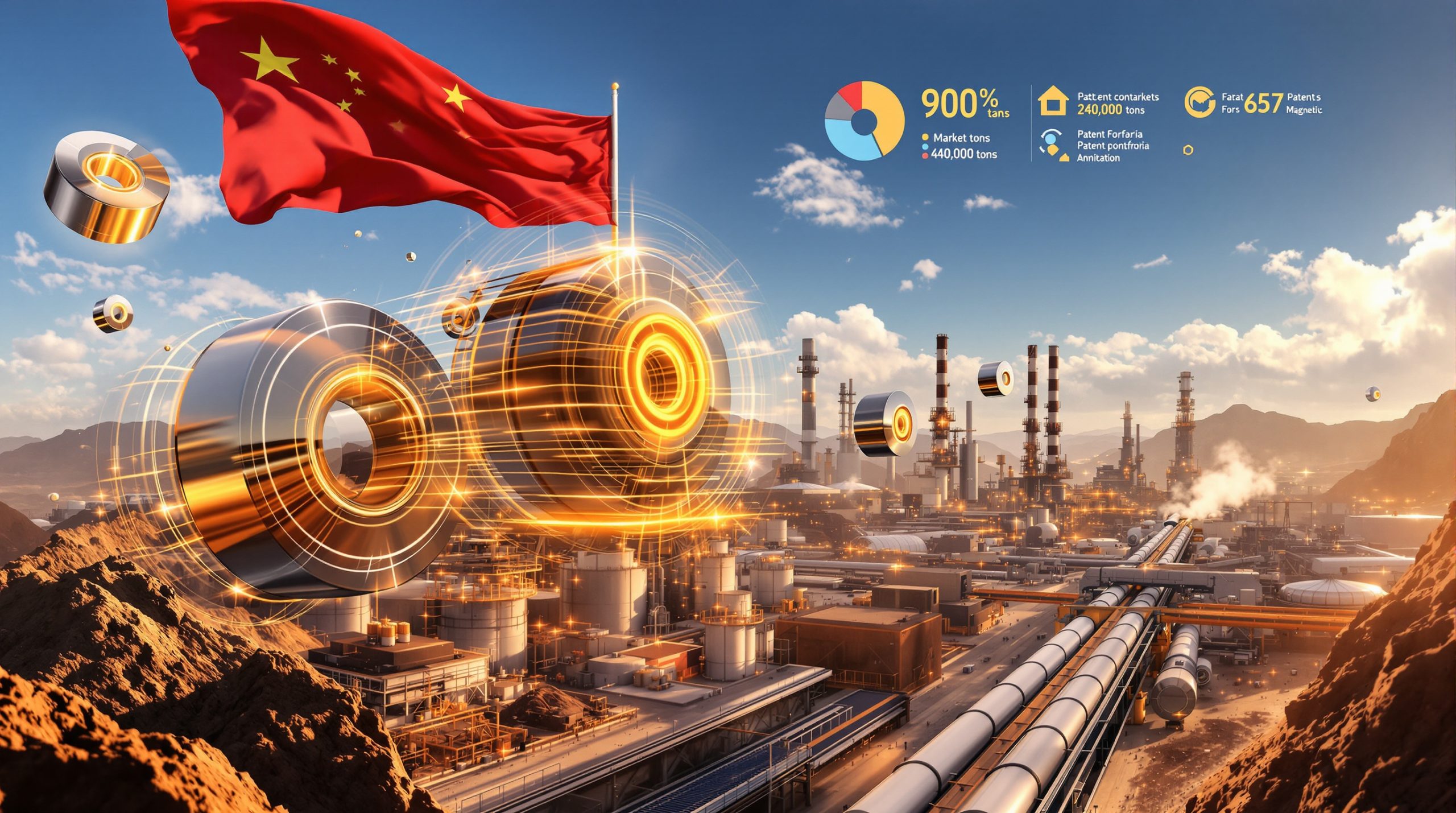ASEAN nations are positioned at the forefront of a transformative ASEAN critical minerals opportunity that could reshape global supply chains and accelerate clean energy transitions worldwide. The region's geological wealth, combined with strategic positioning and growing international partnerships, creates unprecedented potential for economic growth and geopolitical influence.
Regional Resource Abundance and Strategic Location
Southeast Asian nations have emerged as cornerstone suppliers in the global critical minerals landscape, leveraging both geological advantages and strategic positioning to capture unprecedented market opportunities. The region's mineral wealth spans multiple commodities essential for energy transition security and advanced manufacturing processes.
Indonesia leads global nickel production with substantial market influence, while the Philippines possesses extensive untapped mineral reserves valued in the hundreds of billions of dollars. Furthermore, Indonesia nickel giants have distinguished themselves through massive production capacity and strategic partnerships with international buyers.
Malaysia has distinguished itself by developing established rare earth processing infrastructure, positioning the country beyond mere extraction into value-added manufacturing capabilities. Thailand's emergence as a significant tin and tungsten producer adds another dimension to regional supply diversity.
Thailand's emergence as a significant tin and tungsten producer adds another dimension to regional supply diversity, while Vietnam continues expanding its bauxite and rare earth extraction operations. This geographic distribution of critical mineral resources across ASEAN member states creates natural redundancy and supply chain resilience that international partners increasingly value.
ASEAN Critical Minerals Production Share
| Mineral | Estimated Regional Share | Primary Producers |
|---|---|---|
| Nickel | 40%+ | Indonesia, Philippines |
| Tin | 30%+ | Malaysia, Thailand |
| Bauxite | 20%+ | Vietnam, Indonesia |
| Rare Earths | 10%+ | Malaysia, Vietnam |
The strategic location of these resources along major shipping routes provides additional competitive advantages. Southeast Asian mineral producers can efficiently serve both established markets in Northeast Asia and emerging demand centers across the Indo-Pacific region.
Processing infrastructure development varies significantly across the region, with some countries advancing beyond raw material extraction toward refined product manufacturing. This vertical integration capability becomes increasingly valuable as international buyers seek stable, processed mineral supplies rather than raw ore shipments.
How Are Geopolitical Tensions Reshaping Global Mineral Supply Chains?
Current geopolitical dynamics have fundamentally altered how nations approach critical mineral sourcing, creating unprecedented opportunities for alternative suppliers with proven reserves and processing capabilities. The concentration of mineral refining capacity in single geographic regions has exposed vulnerabilities that governments and corporations now actively seek to address.
The China Dependency Challenge
Global supply chains currently exhibit concerning concentration patterns, particularly in rare earth element processing where limited geographic diversity creates potential bottlenecks. This concentration affects multiple industries simultaneously, from renewable energy systems to consumer electronics, creating ripple effects across trillion-dollar market segments.
The challenge extends beyond mere production volumes to encompass specialised processing techniques, technological expertise, and established supply relationships that take years to develop. Alternative suppliers must demonstrate both raw material access and processing competencies to attract long-term partnerships from international buyers.
Nations worldwide are racing to reduce critical mineral dependencies, creating unprecedented opportunities for alternative suppliers with proven reserves and processing capabilities.
Strategic Diversification Imperatives
International partnerships now prioritise supply chain diversification as a fundamental risk management strategy. Recent diplomatic developments demonstrate this shift, with major economies actively engaging ASEAN nations to establish alternative supply channels.
The emphasis on diversification reflects broader economic security considerations, where mineral supply disruptions could potentially impact national clean energy transition timelines and technological competitiveness. This creates strong incentives for long-term partnerships that extend beyond traditional commodity trading relationships.
Investment flows increasingly target projects that contribute to supply chain diversification, with financial institutions and government agencies providing preferential support for initiatives that reduce single-source dependencies. This trend benefits ASEAN producers who can demonstrate reliable production capacity and regulatory compliance.
What Recent Diplomatic Breakthroughs Signal ASEAN's Rising Importance?
US-ASEAN Critical Minerals Partnerships
October 2025 marked a significant acceleration in bilateral critical minerals cooperation, with the United States establishing formal frameworks with multiple ASEAN partners. These agreements represent more than traditional trade relationships, encompassing technology transfer, investment facilitation, and strategic supply chain integration.
The Malaysia-US rare earth memorandum signed during the ASEAN Summit demonstrates how regional producers can leverage existing processing infrastructure to attract international partnerships. Malaysia's established processing capacity distinguishes it from countries possessing only undeveloped reserves, providing immediate value to partners seeking operational supply sources.
Thailand's critical minerals framework with the United States reflects the broader regional trend toward strategic mineral partnerships that extend beyond simple buyer-seller relationships. These agreements typically include provisions for technology sharing, workforce development, and long-term supply commitments that benefit both parties.
Timeline of Recent Agreements:
• October 2025: Malaysia-US rare earth memorandum establishment
• October 2025: Thailand-US critical minerals framework signing
• Ongoing: Additional bilateral negotiations across the region
• Active discussions: Investment protocol development with multiple partners
Multilateral Engagement Expansion
Beyond bilateral arrangements, ASEAN nations are increasingly integrating into multilateral mineral security frameworks that span multiple continents and economic partnerships. These broader coalitions provide additional market access while distributing geopolitical risks across diverse partner relationships.
European engagement in Southeast Asian mineral markets reflects the continent's own diversification objectives as it implements ambitious green transition policies. Japanese partnerships leverage technological expertise and established trade relationships to develop comprehensive supply chain solutions.
Australian involvement brings mining industry evolution expertise and geographical proximity advantages, while Indian cooperation reflects the subcontinent's growing industrial base and critical mineral import requirements. This multilateral engagement pattern strengthens ASEAN's position as a central hub in global mineral supply networks.
Which ASEAN Countries Offer the Greatest Investment Potential?
Indonesia: The Nickel Production Leader
Indonesia's position as a dominant nickel supplier provides substantial leverage in global battery supply chains, particularly as electric vehicle production expands worldwide. The country's mineral policy reforms and infrastructure investments signal commitment to capturing downstream value-added opportunities beyond raw material exports.
Recent foreign investment flows into Indonesian nickel projects reflect international recognition of the country's strategic importance in clean energy supply chains. Processing facility development aims to produce battery-grade materials rather than raw nickel ore, significantly increasing per-unit value and economic impact.
The Indonesian government's approach to mineral export regulations demonstrates sophisticated understanding of supply chain dynamics, using policy tools to encourage domestic processing while maintaining attractive conditions for international partners. This strategy positions Indonesia as a key player in battery material manufacturing rather than merely ore extraction.
Key Investment Metrics:
• Annual production capacity exceeding 1.5 million tonnes
• Foreign investment commitments approaching $8 billion in recent years
• Processing capacity expansion projects targeting 2030 completion
• Battery-grade nickel facility development across multiple provinces
Philippines: Substantial Untapped Potential
The Philippines maintains extensive mineral reserves across multiple commodity categories, representing significant long-term value creation opportunities for both domestic and international investors. The country's geological surveys have identified substantial copper, gold, and chromite deposits that remain largely underdeveloped.
Resource assessment indicates mineral reserves valued potentially in the hundreds of billions of dollars, though actual development timelines depend on regulatory frameworks, infrastructure availability, and environmental compliance requirements. The scale of these reserves positions the Philippines as a potential major supplier across multiple mineral categories simultaneously.
Recent policy developments suggest growing government commitment to responsible mineral development that balances economic opportunities with environmental protection and community benefits. This regulatory evolution could unlock substantial investment flows while maintaining sustainable development practices.
Resource Highlights:
• Extensive copper deposits across multiple geological formations
• Significant gold reserves in both hard rock and alluvial deposits
• Substantial chromite production supporting industrial applications
• Diverse mineral portfolio spanning multiple critical elements
Malaysia: Processing Infrastructure Advantage
Malaysia's existing rare earth processing capabilities provide immediate value proposition for international partners seeking operational supply chains rather than long-term development projects. This infrastructure advantage significantly reduces the typical decade-long timeline from resource identification to market delivery.
The country's strategic port locations and established logistics networks support efficient global distribution of processed materials. Malaysia's regulatory framework for mineral processing has evolved to attract international investment while maintaining environmental and safety standards that meet global requirements.
Tin smelting operations demonstrate Malaysia's broader mineral processing competencies beyond rare earth elements, indicating capabilities that could extend to additional mineral categories as global demand patterns evolve. The integration of processing facilities with transportation infrastructure creates synergies that benefit the entire supply chain.
Infrastructure Capabilities:
• Operational rare earth separation facilities since establishment
• Substantial tin smelting capacity serving regional markets
• Strategic port access through major Malaysian shipping hubs
• Streamlined regulatory processes for mining and processing permits
How Does ASEAN's Mineral Development Address Global Demand?
Clean Energy Transition Requirements
Global decarbonisation initiatives create substantial demand growth projections across multiple critical mineral categories, with electric vehicle adoption and renewable energy deployment driving unprecedented consumption patterns. Battery manufacturing alone represents transformative growth opportunities that could reshape entire national economies.
Wind turbine magnet requirements continue expanding as offshore wind development accelerates globally, creating sustained demand for rare earth elements with specific magnetic properties. Solar panel component manufacturing requires diverse mineral inputs ranging from silver for electrical connections to specialised semiconductors for photovoltaic cells.
Grid storage system deployment to support renewable energy integration creates additional battery material demand that compounds electric vehicle requirements. These overlapping demand drivers suggest sustained growth trajectories that extend beyond typical commodity cycles.
Projected Demand Growth by Sector:
• Electric vehicle batteries: Substantial percentage increases expected through 2030
• Wind turbine magnets: Significant capacity expansion requirements
• Solar panel components: Major manufacturing capacity increases needed
• Grid storage systems: Massive market growth projections through the decade
Regional Coordination Mechanisms
ASEAN Economic Community frameworks provide institutional structures for coordinating mineral development policies across member states, potentially creating regional synergies that benefit all participants. In addition, the ASEAN Minerals Development Vision establishes long-term cooperation frameworks that enhance collective bargaining power.
Joint environmental standards implementation would ensure consistent sustainability practices across the region while facilitating investment flows from environmentally conscious international partners. Cross-border investment protocols could streamline project development timelines and reduce regulatory uncertainties.
The success of regional coordination depends on balancing individual national interests with collective regional advantages, requiring sophisticated diplomatic and economic management as mineral development accelerates across Southeast Asia.
What Infrastructure Developments Support Regional Mineral Ambitions?
Development Finance Mechanisms
Asian Development Bank programs provide substantial financial resources for critical mineral development projects across Southeast Asia, with blended finance solutions that combine public and private capital to reduce investment risks. These programs typically emphasise sustainable development practices and technology transfer components.
Technical assistance programs help regional governments develop regulatory frameworks and institutional capacities necessary for managing large-scale mineral development projects. This support extends beyond financial resources to include knowledge transfer and best practice implementation guidance.
Regional value chain integration receives particular emphasis, with financing structured to encourage cross-border cooperation and shared infrastructure development that benefits multiple countries simultaneously. This approach maximises economic impacts while distributing costs across broader geographic areas.
Investment Program Features:
• Multi-billion dollar critical minerals development funds
• Blended finance solutions combining multiple funding sources
• Technical assistance for sustainable mining transformation practices
• Regional coordination and integration support mechanisms
Strategic Transportation Networks
Transportation infrastructure development focuses on creating efficient pathways from extraction sites to processing facilities and export terminals, reducing logistics costs that can significantly impact mineral project economics. Pipeline systems for refined materials offer particular advantages for high-volume, consistent flows.
Processing alliance development between neighbouring countries creates opportunities for specialisation and efficiency gains that benefit regional competitiveness. Direct shipping agreements with major importing nations reduce intermediary costs while strengthening bilateral trade relationships.
Battery materials supply chains require specialised handling and quality control systems that extend beyond traditional mineral transportation networks. These requirements drive infrastructure investments that support higher-value manufacturing activities within the region.
How Do Environmental Standards Shape Competitive Positioning?
Sustainable Practice Implementation
Environmental regulations across ASEAN nations increasingly align with international best practices, creating competitive advantages for regional producers serving environmentally conscious markets. Indonesian environmental mining regulations demonstrate commitment to balancing resource development with ecosystem protection.
Responsible mining certification programs in countries like the Philippines establish frameworks for community engagement and environmental impact management that meet international investor requirements. These programs often include benefit-sharing mechanisms that ensure local communities participate in mineral development benefits.
Zero-discharge processing standards in Malaysia and community benefit requirements in Thailand reflect regional commitment to sustainable development practices that support long-term industry viability. These standards attract international partners seeking responsible supply chain solutions.
International Certification Integration
Regional producers increasingly adopt international mining standards that facilitate access to global markets while ensuring environmental and social compliance. Initiative for Responsible Mining Assurance (IRMA) certification provides third-party validation of sustainable practices.
London Metals Exchange responsible sourcing requirements create market incentives for certified production, while EU Due Diligence Regulations establish mandatory compliance frameworks for European imports. US Conflict Minerals protocols add additional compliance requirements that benefit certified regional producers.
Standards Adoption Timeline:
• IRMA compliance implementation across multiple countries
• LME responsible sourcing requirement alignment
• EU Due Diligence Regulation preparation activities
• US regulatory compliance protocol development
What Diversification Strategies Reduce Single-Source Dependencies?
Alternative Processing Development
Non-Chinese refining capacity development requires substantial technology transfer partnerships and infrastructure investments that ASEAN nations are increasingly attracting through strategic bilateral agreements. Japanese processing partnerships provide technological expertise while European rare earth separation facilities offer market access.
However, Australian critical reserves partnerships leverage mining industry expertise to accelerate facility development timelines, while Indian manufacturing alliances create additional market outlets for processed materials. These partnerships distribute technological dependencies across multiple international relationships.
Supply Chain Resilience Achievements
Regional dependency reduction initiatives demonstrate measurable progress toward supply chain diversification objectives, with processing capacity increasingly distributed across multiple geographic locations. Strategic stockpile agreements with partner nations provide additional supply security buffers.
Emergency supply protocols establish frameworks for managing potential disruptions while maintaining consistent delivery commitments to international partners. These protocols reflect sophisticated understanding of supply chain risk management principles.
Risk Reduction Metrics:
• Substantial reduction in single-source dependencies for key minerals
• Processing capacity diversification targets for 2030
• Strategic stockpile agreements established with multiple nations
• Emergency supply protocols implemented across the region
Which Investment Opportunities Offer Optimal Returns?
Downstream Processing Development
Value-added manufacturing represents the highest return potential within mineral supply chains, transforming raw materials into specialised components that command premium pricing. Battery precursor chemical production requires sophisticated processing capabilities but generates substantially higher margins than ore exports.
Permanent magnet manufacturing facilities serve growing renewable energy and electric vehicle markets with products that integrate multiple rare earth elements into high-performance components. Semiconductor-grade material processing demands extreme precision but accesses markets with premium pricing and long-term supply contracts.
Renewable energy component assembly creates opportunities to integrate mineral processing with manufacturing activities that serve rapidly growing clean energy markets. This vertical integration approach maximises value capture while strengthening supply chain relationships.
Technology Partnership Frameworks
Research and development collaborations between regional producers and international technology companies accelerate innovation while sharing development costs and risks. University-industry partnerships provide workforce development while advancing mineral science applications.
Pilot plant development initiatives allow testing of new processing technologies before full-scale implementation, reducing investment risks while demonstrating capabilities to potential partners. Intellectual property sharing agreements facilitate technology transfer while protecting proprietary innovations.
What Implementation Challenges Require Management?
Infrastructure and Capacity Limitations
Port facility expansion requirements across the region demand substantial capital investments to accommodate growing mineral export volumes and specialised handling equipment for processed materials. Skilled workforce training needs encompass both traditional mining expertise and advanced processing technologies.
Power grid reliability improvements become critical as processing facilities require consistent electricity supply for continuous operations. Transportation network upgrades must accommodate increased cargo volumes while maintaining environmental standards and community access requirements.
Regulatory and Environmental Considerations
Permitting process standardisation across ASEAN nations would streamline project development while maintaining appropriate environmental protections and community consultation requirements. Environmental impact assessment harmonisation could reduce redundant studies while ensuring comprehensive evaluation of development proposals.
International trade law compliance requires sophisticated legal frameworks that accommodate bilateral agreements while maintaining WTO compatibility and regional trade arrangement obligations. Community consultation requirements demand meaningful engagement processes that respect indigenous rights and local development priorities.
How Will Regional Influence Evolve in Global Energy Transition?
Production Expansion Projections
Capacity development targets across the region reflect ambitious growth projections that could fundamentally alter global mineral supply patterns by 2030. Nickel production expansion alone represents potential for substantially increased global market influence, while rare earth processing capacity growth could reduce global concentration risks.
Battery materials supply chain development positions ASEAN nations to capture growing electric vehicle and energy storage markets, with export values potentially reaching tens of billions of dollars annually. Clean energy mineral exports could become major contributors to regional economic growth and international trade balances.
Strategic Partnership Evolution
Long-term collaboration frameworks extend beyond traditional commodity trading relationships toward comprehensive technology and development partnerships. ASEAN-EU Green Deal cooperation creates pathways for sustainable development financing while accessing European clean energy markets.
Indo-Pacific alliance integration positions regional mineral producers within broader strategic frameworks that encompass security, technology, and economic cooperation. These multilateral partnerships provide stability and diversification benefits that support long-term industry development.
Future Collaboration Frameworks:
• European Green Deal mineral partnership development
• Indo-Pacific strategic materials cooperation
• Quad nations supply chain integration initiatives
• Broader international mineral security protocols
ASEAN's Transformative Critical Minerals Opportunity
The convergence of abundant regional resources, strategic geographic positioning, and growing international demand creates unprecedented opportunities for ASEAN nations to become central players in global critical mineral supply chains. This ASEAN critical minerals opportunity extends beyond traditional commodity exports toward integrated value-added manufacturing and strategic partnership development.
Regional Competitive Advantages:
• Diverse mineral reserves distributed across multiple countries
• Established processing infrastructure and expanding capabilities
• Strategic location serving major global markets efficiently
• Growing international partnership momentum and diplomatic support
• Commitment to sustainable development practices and environmental standards
The ASEAN critical minerals opportunity represents potential economic value generation in the hundreds of billions of dollars while supporting worldwide decarbonisation objectives. Success requires continued investment in infrastructure, technology, and workforce development while maintaining environmental standards and community engagement that support long-term industry sustainability.
Regional coordination and international cooperation will determine how effectively ASEAN nations can capitalise on this transformative moment in global mineral supply chain evolution. The foundation exists for substantial economic growth and strategic influence, with implementation quality determining ultimate outcomes for this unprecedented ASEAN critical minerals opportunity.
This analysis is based on publicly available information and current market trends. Investment decisions should consider individual risk factors and seek professional financial advice. Mineral market projections involve inherent uncertainties and actual results may vary significantly from forecasted scenarios.
Seeking Exposure to ASEAN's Critical Minerals Boom?
Discovery Alert's proprietary Discovery IQ model delivers real-time notifications on significant ASX mineral discoveries, instantly empowering subscribers to identify actionable opportunities ahead of the broader market. Explore how historic mineral discoveries can generate substantial returns and begin your 30-day free trial today to secure your market-leading advantage.




